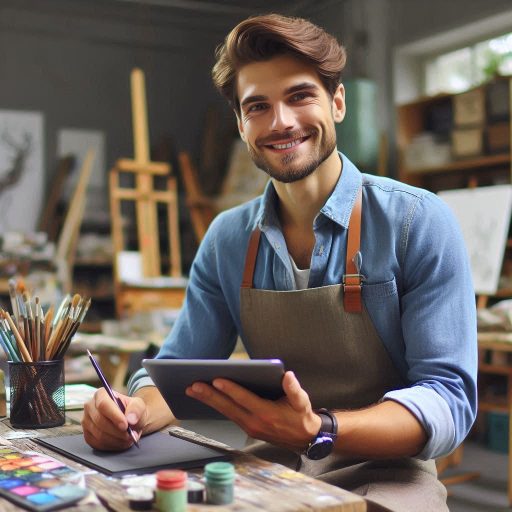Introduction
Art education fosters creativity, critical thinking, and cultural appreciation.
It enriches students’ lives by encouraging self-expression and imagination.
Art educators and instructors play a crucial role in guiding students through this journey.
Art educators and instructors wear many hats.
They are mentors, motivators, and facilitators.
Their roles include developing curriculum, teaching techniques, and assessing student progress.
They create environments where students feel inspired and supported.
To excel in art education, possessing specific skills is essential.
Strong communication skills enable educators to convey concepts clearly and engage students effectively.
Organizational skills help manage classroom activities and materials efficiently.
Creativity is vital for developing innovative lessons and keeping students motivated.
Technical expertise in various art forms ensures educators can teach a broad range of techniques.
Empathy and patience allow educators to connect with students and address their individual needs.
In summary, art education is a valuable field that shapes students’ creative futures.
Art educators and instructors must develop a diverse skill set to be effective in their roles.
These skills ensure that they can provide high-quality instruction and support, fostering a positive and productive learning environment.
Understanding of various art mediums
Demonstrating the ability to teach students about different art forms, such as painting, sculpture, drawing, and mixed media.
Possessing knowledge of different techniques and tools used in each art medium.
Knowing how to effectively introduce and guide students through the process of using various art mediums.
Teaching art history and theory
Teaching students about the historical context of different art movements and styles.
Transform Your Career Today
Unlock a personalized career strategy that drives real results. Get tailored advice and a roadmap designed just for you.
Start NowExplaining the fundamental principles of art theory, such as color theory, composition, and perspective.
Facilitating discussions on the significance of art history and theory in contemporary art practice.
Developing strong communication skills
Articulating complex concepts and techniques in a clear and concise manner.
Listening actively to students‘ questions and providing constructive feedback.
Collaborating with colleagues and administrators to create a supportive learning environment for students.
Cultivating creativity and critical thinking
Encouraging students to explore and experiment with new ideas and artistic processes.
Promoting problem-solving skills and fostering a culture of innovation in the classroom.
Challenging students to think critically about their work and develop a unique artistic voice.
Building a supportive and inclusive classroom environment
Creating a safe space where students feel empowered to express themselves creatively.
Celebrating diversity and multicultural perspectives in art education.
Addressing and resolving conflicts or challenges that arise among students in a positive and constructive manner.
Staying informed about current trends in art education
Attending professional development workshops and conferences to stay up-to-date on best practices in art instruction.
Incorporating new technologies and digital tools into art lessons to enhance student learning.
Engaging in ongoing professional development to continuously improve teaching practice and stay relevant in the field of art education.
Collaborating with the broader arts community
Networking with local artists, galleries, and arts organizations to create opportunities for students to engage with the larger arts community.
Participating in community events, exhibitions, and collaborations to showcase student artwork.
Fostering partnerships with other educators and stakeholders to advocate for the importance of arts education in schools and communities.
Adapting teaching strategies to meet diverse learning needs
Differentiating instruction to accommodate students with varying levels of skill and experience in art.
Providing additional support and resources for students with special needs or learning differences.
Using a variety of teaching methods and assessment strategies to ensure that all students have the opportunity to succeed in art education.
Transform Your Career Today
Unlock a personalized career strategy that drives real results. Get tailored advice and a roadmap designed just for you.
Start NowRead: Collaborating with Other Creative Roles
Creative thinking and problem-solving skills
Encouraging students to think outside the box and explore their creativity
As an art educator or instructor, one of the key skills needed is the ability to foster creative thinking and problem-solving in your students.
By encouraging them to think outside the box and explore their creativity, you can help them unleash their full artistic potential.
This involves introducing them to new ideas, techniques, and perspectives that can inspire them to create unique and innovative artworks.
Helping students overcome artistic challenges and obstacles
Moreover, art students often face various challenges and obstacles in their creative process.
Whether it’s a technical difficulty, a lack of inspiration, or self-doubt, it’s important for art educators to guide their students through these challenges.
By offering constructive feedback, emotional support, and practical solutions, you can help students overcome artistic hurdles and grow as artists.
Providing guidance on how to approach and solve artistic problems
In addition, art educators should provide guidance on how to approach and solve artistic problems.
This involves teaching students how to analyze a creative task, brainstorm ideas, experiment with different techniques, and evaluate the results.
By equipping students with problem-solving skills, you can empower them to tackle artistic challenges with confidence and resilience.
Ultimately, creative thinking and problem-solving skills are essential for art educators and instructors to cultivate in their students.
By fostering a supportive and stimulating learning environment, you can help aspiring artists develop the mindset and skills needed to succeed in the art world.
Read: How to Present Your Design Ideas
Communication and Interpersonal Skills‘
Effective communication and strong interpersonal skills are essential for art educators and instructors.
These skills are crucial in creating a positive and engaging learning environment for students.
Building Relationships with Students
Building connections with students is key to fostering a supportive and collaborative atmosphere in the classroom.
Art educators should take the time to get to know their students individually, understand their interests and motivations, and create a safe space where students feel comfortable expressing themselves creatively.
Communication of Instructions and Feedback
Clear and concise communication of instructions is vital in ensuring that students understand the goals and expectations of their assignments.
Art educators should be able to explain complex concepts in a way that is easily understandable to students of all levels.
Providing constructive feedback is also crucial in helping students improve their skills and grow as artists.
Transform Your Career Today
Unlock a personalized career strategy that drives real results. Get tailored advice and a roadmap designed just for you.
Start NowCollaboration with Colleagues and Parents
Art educators often work in a team environment, collaborating with other teachers and staff to support student success.
By working together with colleagues, educators can share ideas, resources, and best practices to enhance the overall learning experience for students.
Additionally, involving parents in the education process can provide valuable insights into a student’s strengths, weaknesses, and interests, leading to more personalized and effective instruction.
In essence, strong communication and interpersonal skills are essential for art educators and instructors to create a supportive and collaborative learning environment.
By building relationships with students, communicating effectively, and collaborating with colleagues and parents, educators can help students reach their full potential and foster a lifelong love of art.
Read: Historic Costume Design Inspirations

Curriculum development and lesson planning
Creating engaging lesson plans that cater to diverse learning styles and abilities
Developing a well-rounded curriculum is essential for art educators and instructors.
This involves creating engaging lesson plans that cater to diverse learning styles and abilities.
By incorporating various teaching strategies, such as visual, auditory, and kinesthetic methods, art educators can effectively reach all students in the classroom.
Incorporating art history and theory into lesson plans
In addition to considering different learning styles, art educators must also incorporate art history and theory into their lesson plans.
Understanding the historical context of art movements and the underlying concepts of artistic expression can provide students with a more comprehensive education in the visual arts.
Aligning lessons with educational standards and objectives
Moreover, aligning lessons with educational standards and objectives is crucial for ensuring that students are meeting the necessary requirements for their academic development.
By following established guidelines and benchmarks, art educators can track student progress and make adjustments to their teaching methods as needed.
Overall, curriculum development and lesson planning are essential skills for art educators and instructors.
By creating engaging and thoughtful lesson plans that cater to diverse learning styles, incorporating art history and theory, and aligning lessons with educational standards, art educators can provide their students with a well-rounded and comprehensive art education.
Read: Breaking Down Iconic Movie Costumes
Classroom management and organization
Effective classroom management is crucial for art educators and instructors to create a conducive environment for teaching and learning.
It involves various strategies and techniques to ensure that students are engaged, productive, and focused on their artistic endeavors.
Here are some key components of classroom management and organization that art educators should focus on:
Physical Environment‘
Art classrooms should be organized and equipped with the necessary materials and tools for creating art.
Transform Your Career Today
Unlock a personalized career strategy that drives real results. Get tailored advice and a roadmap designed just for you.
Start NowThis includes having designated spaces for different art techniques, such as painting, drawing, sculpture, etc.
A well-organized classroom can inspire creativity and encourage students to explore their artistic capabilities.
Establishing Rules and Expectations‘
Setting clear guidelines and expectations for behavior and performance helps create a structured learning environment.
Art educators should communicate these expectations to students at the beginning of the course to ensure that everyone is on the same page.
Consistency in enforcing rules is key to maintaining order in the classroom.
Time Management‘
Managing time effectively during classes and workshops is crucial for ensuring that all planned activities and projects are completed.
Art educators should create a realistic schedule that allows for adequate time for instruction, practice, and feedback.
Time management skills help art instructors stay on track and make the most of the limited class time.
Communication‘
Effective communication with students is essential for maintaining a positive and productive classroom environment.
Art educators should be clear and concise in their instructions, provide constructive feedback, and encourage open dialogue with students.
Building strong relationships based on trust and respect helps foster a collaborative learning environment.
Flexibility‘
Being flexible and adaptable is important for art educators when managing a diverse group of students with varying learning styles and abilities.
Flexibility allows instructors to adjust their teaching methods and approaches to meet the unique needs of each student.
It also enables educators to respond to unexpected situations and challenges that may arise during class.
Basically, classroom management and organization are essential skills for art educators and instructors.
By maintaining a well-structured classroom environment, setting clear expectations, managing time effectively, and practicing effective communication, educators can create a positive and inspiring learning environment for their students.
Flexibility and adaptability
Being open to changes and adjustments in curriculum or lesson plans
Art educators and instructors need to possess a high level of flexibility and adaptability in order to effectively navigate the dynamic and ever-changing landscape of art education.
This skill is essential for teachers who want to create a positive and successful learning environment for their students.
One of the key aspects of flexibility in art education is the ability to be open to changes and adjustments in curriculum or lesson plans.
As new ideas and techniques emerge in the art world, educators must be willing to incorporate these elements into their teaching to provide students with a comprehensive and up-to-date education.
Transform Your Career Today
Unlock a personalized career strategy that drives real results. Get tailored advice and a roadmap designed just for you.
Start NowAbility to work with students of various ages and skill levels
Additionally, art instructors must be able to work with students of various ages and skill levels.
From young children to adults, and from beginners to advanced artists, educators need to tailor their teaching methods to meet the unique needs and abilities of each individual student.
This requires a deep understanding of different learning styles and a willingness to adapt teaching strategies accordingly.
Responding to unexpected challenges or situations in a calm and resourceful manner
Furthermore, unforeseen challenges and situations can arise in the classroom at any moment.
Whether it’s a technical issue with equipment, a disruptive student, or an unexpected change in schedule, art educators must be able to respond to these situations calmly and resourcefully.
This requires quick thinking, problem-solving skills, and a positive attitude to maintain a productive and supportive learning environment for students.
All in all, flexibility and adaptability are crucial skills for art educators and instructors to possess in order to succeed in the field of art education.
By being open to change, able to work with diverse students, and responding to unexpected challenges, educators can create a dynamic and enriching learning experience for their students.
Continuing Education and Professional Development
Pursuing Ongoing Training and Workshops to Enhance Teaching Skills
Art educators and instructors should consistently seek out training and workshops.
These opportunities allow them to refine their teaching techniques and learn new methods.
By participating in relevant workshops, educators stay current with innovative practices.
This commitment to growth helps them deliver engaging and effective art lessons.
Attending workshops also provides exposure to diverse perspectives, enhancing their ability to address various student needs.
Continuous learning ensures that educators can adapt to evolving educational standards and integrate fresh ideas into their curriculum.
Staying Up-to-Date with Current Trends and Developments in the Field of Art Education
Keeping up with trends in art education is crucial.
Educators should regularly read industry publications and attend conferences to stay informed.
Awareness of new techniques, technologies, and educational philosophies enables educators to incorporate cutting-edge practices into their teaching.
Understanding these developments helps educators maintain relevance and offer contemporary content to their students.
Staying updated also supports educators in making informed decisions about curriculum changes and instructional methods.
This proactive approach to knowledge ensures that their teaching remains innovative and effective.
Transform Your Career Today
Unlock a personalized career strategy that drives real results. Get tailored advice and a roadmap designed just for you.
Start NowNetworking with Other Professionals in the Field to Share Ideas and Resources
Networking with fellow art educators offers valuable benefits.
By connecting with others in the field, educators can exchange ideas and strategies.
Collaborative discussions often lead to new insights and innovative approaches.
Sharing resources such as lesson plans and teaching materials enriches their educational practices.
Attending professional gatherings, joining online communities, and participating in forums foster these connections.
Building a robust network of peers enhances their teaching toolkit and provides support and inspiration.
Effective networking also opens doors to potential collaborations and professional growth opportunities.
Essentially, ongoing education, staying current with trends, and networking are essential for art educators.
These practices ensure continuous improvement and relevance in their teaching careers.
Discover More: Importance of User Experience in Game Design
Conclusion
Art educators and instructors need a diverse skill set to thrive in their roles.
These skills enable them to foster creativity, engage students, and manage their classrooms effectively.
Being an art educator requires more than just artistic talent.
Strong communication skills are essential for clearly conveying concepts and feedback.
Patience is crucial for guiding students through their creative processes and helping them overcome challenges.
Organizational skills help manage lesson plans, materials, and classroom dynamics efficiently.
Additionally, understanding various art techniques and staying updated with trends allows educators to offer relevant and engaging instruction.
Flexibility is key in adapting teaching methods to suit different learning styles and needs.
By mastering these skills, art educators create a supportive and stimulating environment that enhances student learning and growth.
Aspiring art educators should embrace continuous learning and skill development.
Transform Your Career Today
Unlock a personalized career strategy that drives real results. Get tailored advice and a roadmap designed just for you.
Start NowCultivating a broad skill set will not only enhance their teaching abilities but also contribute to their overall career satisfaction.
Engaging in professional development opportunities, attending workshops, and seeking feedback can greatly improve their effectiveness.
Encouraging students to explore their creativity and providing constructive feedback will become second nature with practice.
Passion for both art and teaching is essential for long-term success.
By dedicating themselves to honing these skills, aspiring art educators can make a significant impact in their field.
They will inspire and shape the next generation of artists, making their efforts both rewarding and impactful.
In the end, a diverse skill set is fundamental for success as an art educator or instructor.
Continuous skill enhancement will pave the way for a fulfilling and influential career in art education.




